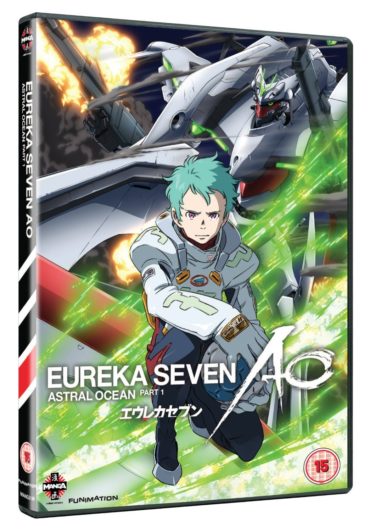Eureka Seven AO (Astral Ocean) Volume 1
Ao Fukai (thirteen) is about to start middle school. But this is 2025 and his island home off Okinawa is caught up in a strange and devastating conflict between alien life forms: the Scub Coral, which first appeared ten years ago, and the G-Monsters, or ‘secrets’, black and pink entities of enormous and unpredictable destructive power. And Ao is something of an alien himself, having been born to a mysterious blue-haired woman, Eureka, who came tumbling out of the sky…and then disappeared a few years later. During an attack by a G-Monster, Ao finds himself piloting a giant humanoid mecha, Nirvash (that no one else has been able to pilot) to defend his home.
As the world powers argue over the fate of the islands and the precious Scub Coral, Ao becomes a member of Team Pied Piper, part of Generation Bleu, a vast organization run by Christophe Blanc to fight the G-Monsters and defend the Earth. Ao is not alone, as Pied Piper already use two other mecha, the Kyrie and the Alleluia, piloted by Fleur Blanc, Christophe’s daughter, and pink-haired Eleanor Peoples. Ao has many questions of his own: why has his hair turned blue since he found the Nirvash; why can only children pilot the mecha; and does Generation Bleu know anything about his mother?
But there is another threat looming in the shape-shifting form of another blue-haired young man calling himself ‘Truth’; after several lethal attacks, it becomes obvious that Truth has designs on Nura, Ao’s best friend on the island, a girl whose health has been severely affected by the alien attacks. Ao is desperate; how can he protect Nura and find out what has become of his mother, Eureka, before Truth’s ruthless attacks destroy everything he cares about?
It’s no spoiler to reveal that Ao is the son of Eureka, the heroine of Eureka Seven as the blurb from the distributors makes that quite clear. The mystery as to how Ao, his mother, and her mecha Nirvash happen to have ended up in the twenty-first century has yet to be revealed. If you’ve never watched the original series, you won’t be at a loss with this sequel – but you will, nevertheless, be missing out on some intriguing allusions. Episode 12 is especially rich in this respect, with one truly magical reveal – which remains largely unexplained, so we’ll just have to wait for the second set for questions to be answered.
There’s a lot going on in Eureka Seven AO; the series hits the ground running and never really stops to draw breath in these first twelve episodes. In fact there’s so much going on that the story-telling sometimes seems almost random, as if the creative team didn’t quite know which elements to foreground and ended up throwing everything into the mix. The original Eureka Seven had the luxury of fifty episodes in which to develop the story of Renton, the Nirvash mecha, and the mysterious blue-haired alien girl Eureka, so even though it had a vast cast (the crew of the Gekkostate craft that Renton joins, the forces of the military opposition) there was time to develop their backstories and unfold the complex plot in a satisfactory way, making it easier to get to know the central characters. In this sequel, the story gets into its stride once Ao joins Generation Bleu and Team Pied Piper, but there’s still an odd blend of linear plot development and scattershot nuggets of information dropped into the mix to contend with. It still makes for an enjoyable watch though, thanks to high production values. Oh – and there’s Noa, an adorable pet sloth, as well. Every series needs an adorable mascot animal.
Kenichi Yoshida – part of the original Eureka Seven team – lends his distinctive touch to the character design once more and the mecha scenes are thrillingly orchestrated.
Naoki Sato scored the original series with considerable distinction and originality but Koji Nakamura (in what appears to be his first outing as an anime composer) does a good job, providing some memorably pounding backgrounds to the combat scenes and what might well be local/ethnic Okinawan sounds for the island scenes. The stirring Opening Theme: is: “Escape” by Hemenway and the attractively upbeat Ending Theme: is “Stand by me” by Stereopony. Episode 11 boasts an Insert song: “Parallel Sign” by LAMA.
In the US dub, Micah Solusod makes a sympathetic Ao (”I can do this!”) as does Yūtarō Honjō in the original and Todd Haberkorn is genuinely creepy as his nemesis ‘Truth’(although the character design is strangely reminiscent of Studio Ghibli’s portrayal of the magician Howl).
Extras include commentaries by the US dub cast over Episodes 5 and 10, textless Opening and Closing songs, original commercials and the US trailer. Most interesting of the bunch is Inside the Booth, a short film in which VA Brandon Potter (Gazelle) shows a recording session in action with ADR editor Zach Bolton at FUNimation and illustrates just what a complex task it is to translate, re-script and then add the voices to an anime.
In Summary
The sequel to the excellent and complex 2005 series Eureka Seven has some issues with coherent story-telling but makes for a good-looking and exciting (if episodic) watch.


